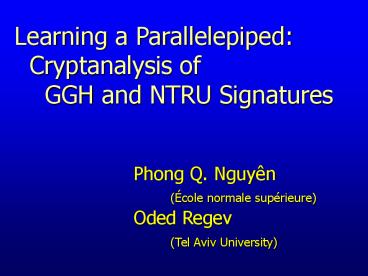Phong Q. Nguy - PowerPoint PPT Presentation
1 / 28
Title: Phong Q. Nguy
1
Learning a Parallelepiped Cryptanalysis of
GGH and NTRU Signatures
Phong Q. Nguyên (École normale
supérieure) Oded Regev (Tel Aviv University)
2
Outline
3
Lattices
- Basis
- v1,,vn vectors in Rn
- The lattice L is
- La1v1anvn ai integers
v1v2
2v2
2v1
2v2-v1
v1
v2
2v2-2v1
0
4
Basis is not unique
v2
v1
0
5
Closest Vector Problem (CVP)
- CVP Given a lattice and a target vector, find
the closest lattice point - Seems very difficult best algorithms take time
2n - However, checking if a point is in a lattice is
easy
v2
v1
0
6
Babais CVP Algorithm
- Babais algorithm given a point u, write
- and output
- Works well for good bases
7
Babais CVP Algorithm
8
Babais CVP Algorithm
9
Lattice-based Cryptography
- One-way functions based on worst-case hardness
Ajtai96, GoldreichGoldwasserHalevi96,
CaiNerurkar97, MicciancioRegev04 - Public-key cryptosystems based on worst-case
hardness AjtaiDwork97, GoldreichGoldwasserHalevi9
7, Regev04, Regev06 - Other public-key cryptosystems GoldreichGoldwasse
rHalevi97, HoffsteinPipherSilverman98 - Signature schemes
- GGH GoldreichGoldwasserHalevi97,
- NTRUsign HoffsteinHowgraveGrahamPipherSilvermanW
hyte01
10
Signature Schemes
- Consists of
- Key generation algorithm produces a
(public-key,private-key) pair - Signing algorithm given a message and a
private-key, produces a signature - Verification algorithm given a messagesignature
and a public key, verifies that the signature
matches
11
The GGH Signature Scheme
- Idea CVP is hard, but easy with good basis
- The scheme
- Key generation algorithm choose a lattice with
some good basis - Private-key good basis
- Public-key bad basis
- Signing algorithm given a message and a private
key, - Map message to a point in space
- Apply Babais algorithm with good basis to obtain
the signature - Verification algorithm given messagesignature
and a public key, verify that - Signature is a lattice point, and
- Signature is close to the message
12
GGH Signature Scheme
Private-key
Public-key
13
GGH Signature Scheme
Public-key
Message
Signature
Verification 1. should be a lattice point
2. distance between and should be
small
14
The NTRUsign Signature Scheme
- Essentially a very efficient implementation of
the GGH signature scheme - Signature length only 1757 bits
- Signing and verification are faster than
RSA-based methods - Based on the NTRU lattices (bicyclic lattices
generated from a polynomial ring) - Developed by the company NTRU and currently under
consideration by IEEE P1363.1 - Some flaws pointed out in GentrySzydlo02
15
Main Result
- An inherent security flaw in GGH-based signature
schemes - Demonstrated a practical attack on
- GGH
- Up to dimension 400
- NTRUsign
- Dimension 502
- Applies to half of the parameter sets in IEEE
P1363.1 - Only 400 signatures needed!
- The attack recovers the
- private key
- Running time is a few
- minutes on a 2Ghz/2GB PC
16
Main Result
- Possible countermeasures
- Pertubations, as suggested by NTRU in several of
the IEEE P1363.1 parameter sets - Larger entries in private key
- It is not clear if the attack can be extended to
deal with these extensions - Public key encryption schemes and one-way
functions are still secure!! - This includes all schemes based on worst-case
hardness and NTRUencrypt
17
The Attack
18
The Attack
19
Hidden Parallelepiped Problem
Given points sampled uniformly from an
n-dimensional centered parallelepiped, recover
the parallelepiped
20
Hidden Hypercube Problem
Given points sampled uniformly from an
n-dimensional centered unit hypercube, recover
the hypercube
21
HHP First Attempt
22
HHP Second Attempt
23
HHP The Algorithm
24
Back to HPP
25
Back to HPP
26
Were not alone
- The HPP has already been looked at
- In statistical analysis, and in particular
Independent Component Analysis (ICA). The FastICA
algorithm is very similar to ours
HyvärinenOja97. Many applications in signal
processing, neural networks, etc. - In the computational learning community, by
FriezeJerrumKannan96. A somewhat different
algorithm. - However, none gives a rigorous analysis. We
analyze the algorithm rigorously, taking into
account the effects of noise
27
Open questions
28
(No Transcript)

